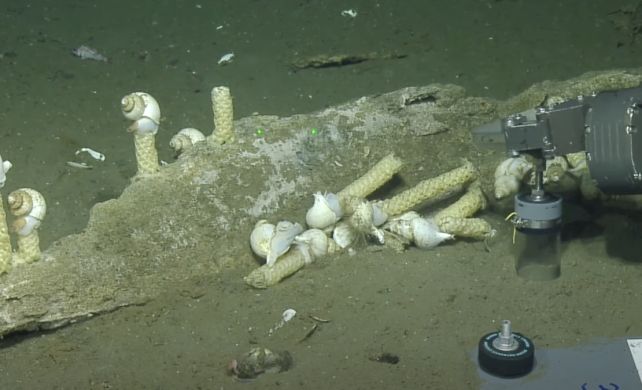As life comes to an end, so too does life go on. This is true even in the benthic depths, where the bounty of a fallen whale carcass created and continues to support a mini ecosystem for decades after the whale's death.
And the remains of a whale deep under the waters of the North Pacific are helping scientists understand how these remains allow ecosystems to thrive.
These massive carcasses are known as "whale fall", and this one was discovered 1,250 meters (4,100 feet) deep off the coast of British Columbia at a site known as Clayoquot Slope in 2009 by Monterey Bay Aquarium Research Institute researchers.
Since 2012, scientists with Ocean Networks Canada (ONC) have returned to the site often to study the skeleton's decomposition rate and track the changes in the diversity of marine life living there, feasting on the rich bounty.
The most recent visit took place as part of an expedition undertaken by the Ocean Exploration Trust's (OET) EV Nautilus to help ONC check on the underwater observatories currently operating on Clayoquot Slope.
While in the area, the ROV Hercules – a remotely operated submersible – also took high-resolution video and a photogrammetry survey of the whale fall, led by benthic ecologist Fabio De Leo of ONC.

"Whale falls represent an oasis of food supply in an often food-poor deep-sea floor and sustain a diverse assemblage of marine organisms," OET writes in a blog post.
In 2019, Monterey Bay National Marine Sanctuary scientists discovered a much fresher whale fall on the 3,200-meter-deep Davidson Seamount. At around four months old, that carcass was crawling with octopuses, eelpouts, worms, grenadiers, and crabs.
The Clayoquot whale fall is in shallower waters, but even there, the seafloor is shrouded in permanent darkness, as the Sun's rays can't penetrate to bathypelagic depths.
It's unclear what species the Clayoquot whale fall belonged to. However, De Leo notes that the site is near a gray whale (Eschrichtius robustus) migration route, so that identification seems likely. And, even 14 years after the carcass was discovered, the site is still teeming with life.
"The skeleton supports a rich benthic fauna," OET writes.
The species observed include limpets (Cocculina craigsmithi), sea snails (Mitrella (Astyris) permodesta), isopods (Ilyarachna profunda), crabs (Paralomis multispina), rattail fish (Coryphaenoides acrolepis), and tube worms (Lamellibrachia cf. barhami).
"These tube worms, likely the same individuals seen in 2009, are still making a home on the left jaw bone of the whale, which is remarkable," writes OET.

You'll also notice that many of the sea snails seem to be perched atop tall columns, like little sentries; those columns are their eggs. This replenishes the whale fall ecosystem, not just in the form of new baby sea snails, but food, as other animals (such as crabs) will feast on the eggs.
In addition to the survey, the researchers also took samples of the seafloor sediment from the area around the whale fall. They will test the samples for environmental DNA, which will help build a more accurate survey of the organisms lurking, feeding, and thriving in the corpse-fed dark.
You can follow along with the adventures of EV Nautilus on the Ocean Exploration Trust's Nautilus Live website.
